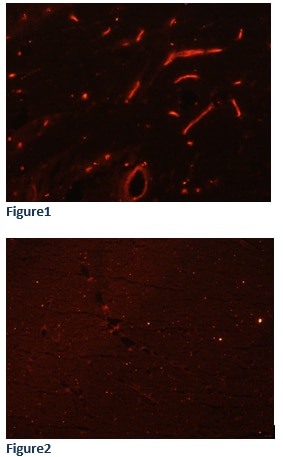| Reactivity | Hu, RtSpecies Glossary |
| Applications | ELISA, Flow, ICC/IF |
| Clone | ICO-115 |
| Clonality | Monoclonal |
| Host | Mouse |
| Conjugate | Unconjugated |
| Concentration | 0.2 mg/ml |
| Description | 200ug/ml of antibody purified from Bioreactor Concentrate by Protein A or G. Prepared in 10 mM PBS with 0.05% BSA & 0.05% azide. Also available WITHOUT BSA & azide at 1.0 mg/ml. (NBP2-33076) Antibody with azide - store at 2 to 8C. Antibody without azide - store at -20 to -80C. |
| Additional Information | Clone ICO-115 was used by HLDA to establish CD designation. |
| Immunogen | Blast cells of a chronic myeloid leukemia patient |
| Localization | Cell surface |
| Marker | Hematopoietic Stem Cell & Endothelial Marker |
| Specificity | This antibody recognizes a carbohydrate epitope on a single chain, transmembrane, heavily glycosylated protein of 90-120kDa, which is identified as CD34 (VI international workshop on human differentiation antigens). Its expression is a hallmark for identifying pluripotent hematopoietic stem or progenitor cells. Its expression is gradually lost as lineage committed progenitors differentiate. CD34 is a marker of choice for staining blasts in acute myeloid leukemia. In addition, it is expressed by soft tissue tumors, such as solitary fibrous tumor and gastrointestinal stromal tumor. CD34 expression is also found in vascular endothelium. Additionally, proliferating endothelial cells overexpress this molecule than the non-proliferating endothelial cells. Anti-CD34 labels 85% of angiosarcoma and Kaposis sarcoma, but shows low specificity. |
| Isotype | IgG1 Kappa |
| Clonality | Monoclonal |
| Host | Mouse |
| Gene | CD34 |
| Purity | Protein A or G purified |
| Innovator's Reward | Test in a species/application not listed above to receive a full credit towards a future purchase. |
| Dilutions |
|
|
| Application Notes | ELISA: For coating, order antibody without BSA). Optimal dilution for a specific application should be determined. |
|
| Reviewed Applications |
|
|
| Publications |
|
| Storage | Store at 4C. |
| Buffer | 10 mM PBS with 0.05% BSA |
| Preservative | 0.05% Sodium Azide |
| Concentration | 0.2 mg/ml |
| Purity | Protein A or G purified |
| Images | Ratings | Applications | Species | Date | Details | ||||||||||
|---|---|---|---|---|---|---|---|---|---|---|---|---|---|---|---|

Enlarge |
reviewed by:
Verified Customer |
IHC-Fr | Rat | 09/20/2017 |
Summary
Comments
|
Secondary Antibodies |
Isotype Controls |
Research Areas for CD34 Antibody (NBP2-29455)Find related products by research area.
|
|
Understanding ‘Y’ in Breast Cancer: Crucial Role of DNA/RNA-binding Protein YB-1 in the Development, Pre-Invasive, and Metastatic Phases Jamshed Arslan, Pharm D, PhD In the United States, 1 in 8 women will be diagnosed with breast cancer in her lifetime.1 Despite the prevalence, cancer genesis is a mystery. The heterogeneity of cancers makes it diff... Read full blog post. |
|
The application of CD31/Pecam-1 (MEC 7.46) in breast cancer research CD31/PECAM-1, or platelet endothelial cell adhesion molecule 1, is a 130-kDa glycoprotein expressed on vascular and hematopoietic cells. Depending on the cell type, CD31/PECAM-1 expression can be largely localized to cell junctions, playing a rol... Read full blog post. |
|
CD68 (Cluster of differentiation 68, GP110, LAMP4, SCARD1) CD68 belongs to a growing family of hematopoietic mucin-like molecules known as lysosomal/endosomal-associated membrane glycoproteins (LAMPs). Other LAMP family members included leukosialin, stem cell antigen CD34, and GlyCAM-1. CD68 encodes a 110-kD ... Read full blog post. |
|
CD34 (Cluster of differentiation 34, hematopoietic progenitor cell antigen) CD34 is a cell-surface glycoprotein type 1 transmembrane protein that belongs to the sialomucin family. CD34 comprises of an intracellular cytoplasmic domain with consensus sites for serine, threonine, tyrosine and active protein kinase C (PKC). Becau... Read full blog post. |
|
CD34 Serves as an Important Marker in Disease Research CD34 is a membrane protein that aids cells in cell-cell adhesion. Although little is known about its function, CD34 is an important marker for hematopoietic stem cells (HSCs), muscle satellite cells, and endothelial c... Read full blog post. |
|
CD34 Serves as an Important Marker in Disease Research CD34 is a cell surface glycoprotein that aids cells in cell-cell adhesion. It is expressed on endothelial cells where it is known to bind L-selectin and may aid in migration of T-cells. Moreover, it is expressed on hematopoietic stem cells (HSC), musc... Read full blog post. |
The concentration calculator allows you to quickly calculate the volume, mass or concentration of your vial. Simply enter your mass, volume, or concentration values for your reagent and the calculator will determine the rest.